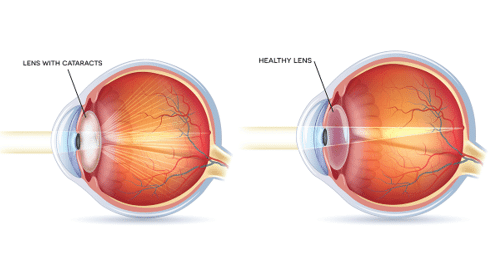Cataracts are the most common treatable cause of vision loss in people over 40. Can you prevent them?
Cataracts are an inevitable part of the ageing process but what are they and can we do anything to prevent them?

What is cataract?
As we age, the natural (or crystalline) lens of the eye becomes cloudy making things appear blurry or hazy, a little bit like looking though frosted glass.
A leading cause of vision impairment, cataract is a clouding of the clear lens in the eye (which sits just behind the pupil and iris – see diagram).
Symptoms of cataract
Cataracts develop gradually therefore many people are unaware that they are developing them.
GLARE: When sight begins to deteriorate due to cataract, the earliest symptom may be glare. This can be debilitating at night as well as around sunrise / sunset when the sun is low in the sky.
BLUR: A cloudy lens can also dim your vision and cause blur for both distance and near. It may become more difficult to read road signs or the newspaper.
CHANGE: A developing cataract causes your crystalline lens to thicken. This can result in a rapid change in your glasses prescription – becoming less long-sighted or more short-sighted over a few months. If you have frequent changes to your glasses prescription and you are over 50, it could be a cataract.
COLOURS: Colours may be yellowed or washed out. This is actually more obvious after cataract surgery, when your perception of colour returns to normal.
Causes of cataract
AGE: Risk of cataract goes up with age and doubles every decade over 50. You can get cataracts if you are younger (and some babies are born with them) but most people develop cataract in their 60s, 70s or beyond.
UV light: Exposure to UV light increases your risk of cataract. (The older you are, the more UV light you’ve been exposed to). People with fair colouring (of Northern European heritage) or those who spend a lot of time outdoors (such as stockmen and farmers) are more likely to develop cataract at an earlier age.
MEDICATION: Some medications, such as corticosteroids and non-steroidal anti-inflammatory drugs, can cause cataract. People who take these medications for chronic inflammation should have regular eye exams to look for cataract and other changes to their eyes.
SYSTEMIC DISEASE: Diabetes and other systemic diseases can also cause cataracts to make a much earlier appearance than normal.
TRAUMA: If the crystalline lens experiences trauma (through accident, surgery etc) this can also result in cataract.
Prevention
You can’t stop the clock in terms of ageing, but you can protect your eyes from UV exposure by wearing sunglasses and a broad-brimmed hat when outdoors. This particularly applies in Australia where the UV exposure is particularly high.
What happens if you have cataract?
There is only one treatment for cataract and that’s microsurgery, which is highly successful in restoring vision. If you’re diagnosed with this condition, your optometrist will monitor your eyes until your cataracts are impacting on your lifestyle. This is the time to see a cataract surgeon and here at The Eye Practice we refer to the best surgeons in the country.
The Eye Practice has all the specialised equipment required to detect cataract, manage your vision appropriately and refer you to a specialised cataract surgeon in more advanced cases. Cataracts need not affect your lifestyle.
Phone The Eye Practice today to arrange a comprehensive eye examination (02) 9290 1899 or make an appointment online.
PLEASE READ: The information given under Eye Conditions is of a general nature and is not intended to be advice on any particular matter. Please take the appropriate Optometrical advice before acting on any information given under Eye Conditions of The Eye Practice web-site.

